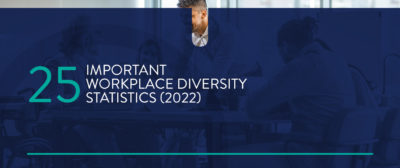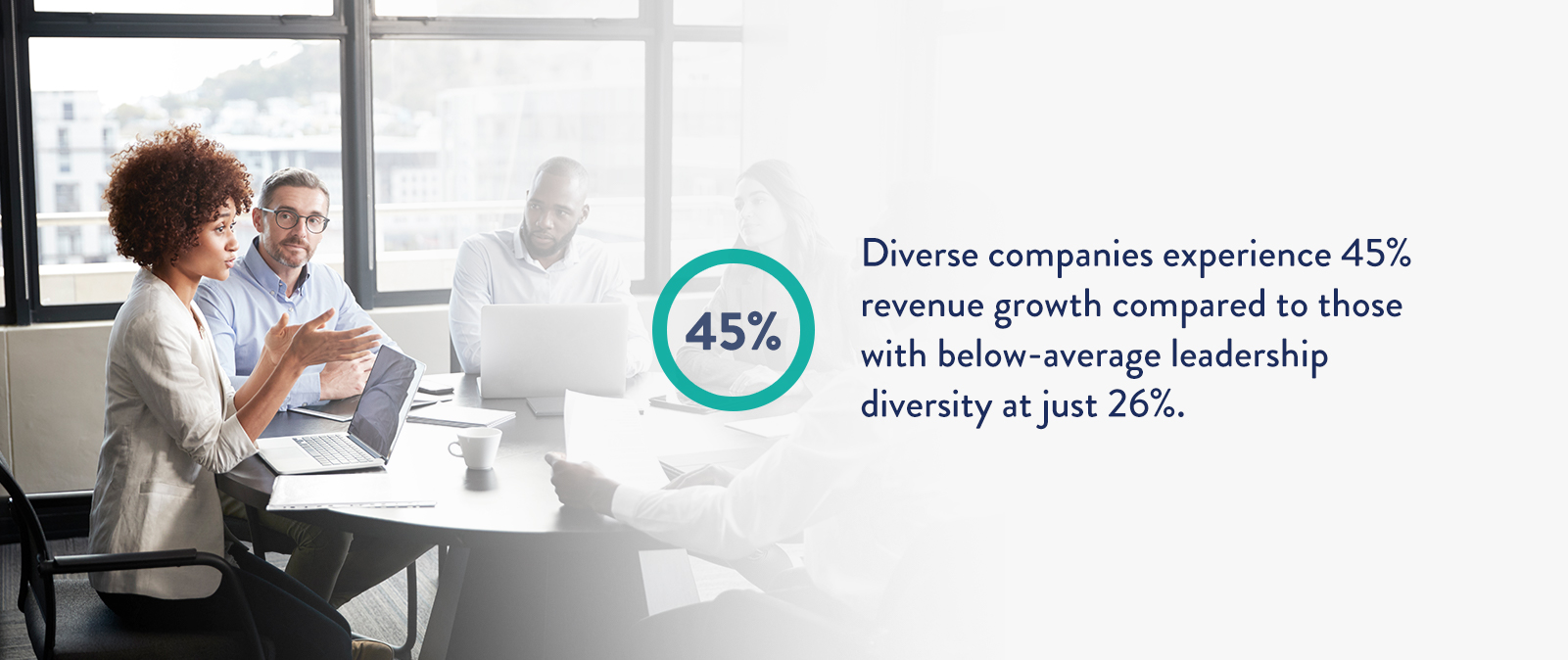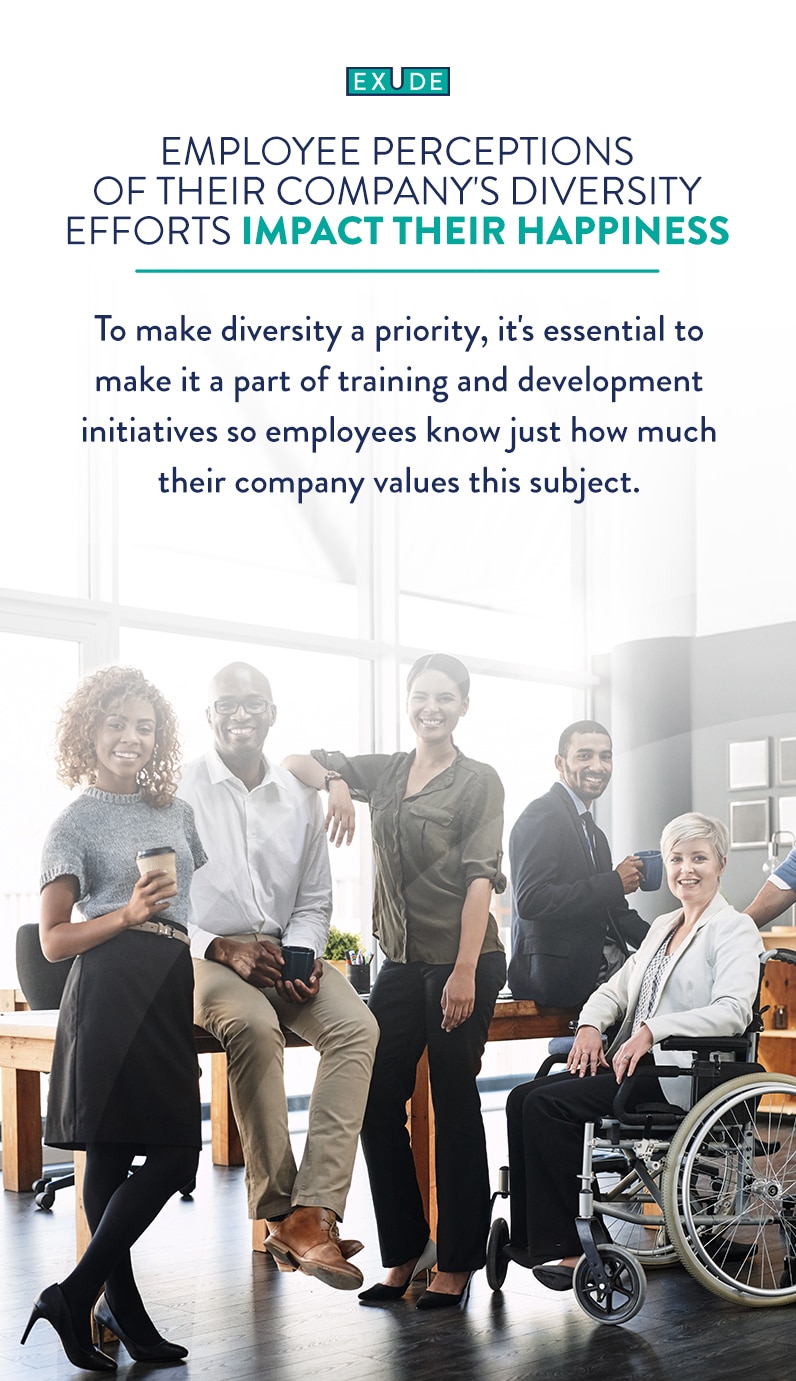DEI
25 Important Workplace Diversity Statistics (2022)

Diversity and inclusion in the workplace are two of the most important factors for hiring managers and HR departments today.
Diverse companies foster an inclusive environment that provides equal rights and opportunities for all workers, regardless of gender, age, sexual orientation or ethnicity. A diverse workforce acknowledges the skills and differences each team member brings to the company and provides a substantial social and cultural impact.
Here are 25 recent workplace diversity statistics to better understand the importance of diversity in the workplace and help you create a more inclusive work environment.
1. Corporations Identified as More Diverse Are 35% More Likely to Outperform Competitors
With technological advancements in the recent decades, it’s no surprise that we live in a more connected, globalized world today. With deeper connections and relationships formed among people of all backgrounds, we now see so many benefits of diversity in the workplace.
While correlation doesn’t equal causation, it seems that when companies choose diverse leadership, they tend to be more successful and have a competitive edge. When accepting candidates from all backgrounds, companies have more of a chance to find and retain top talent.

2. Diverse Management Teams Lead to 19% Higher Revenue
Recent research shows a promising correlation between diversity and increased workplace innovation revenue. Companies reporting above-average diversity among leadership showed higher earnings before interest and taxes (EBIT) margins, with gains generated from just minor changes to their senior team makeups. Diverse companies experience 45% revenue growth compared to those with below-average leadership diversity at just 26%.
These correlations pave the way for a more innovative organization for business leaders. Those with different backgrounds and skillsets will examine problems from varying perspectives and develop new solutions. These perspectives increase the chances of developing successful solutions. Diverse workforces mean companies are more adaptive and prepared for the ever-changing business world.
3. 8.1% of Fortune 500 Companies Have Women CEOs
Fortune 500 companies are ranked among the largest businesses in the country, and the list has long been regarded as a microcosm of U.S. business as a whole. In 2021, the number of women running Fortune 500 companies was 41, or just 8.1%. For the first time, two Black women now run Fortune 500 businesses, while another executive is making history running one of the highest-ranking businesses ever owned by a woman.
These three milestones reflect a shift toward diverse companies and leaders in the U.S. While there’s still a long way to go, they provide a glimpse into the future as the country begins to recognize the importance of diversity in the workplace.
4. Women Are More Likely to be Hired Through Blind Applications
A study conducted by Harvard University and Princeton University found that when men and women submitted anonymous applications or auditions, women’s chances of getting the job increased. Under these same conditions, women were also more likely to be hired than men.
Another study shows men are more likely to be hired, regardless of the hiring manager’s gender. This indicates that women can be biased against other women and highlights the necessity for hiring practices that avoid gender-based proclivities.
5. Companies With Gender Diversity Produce up to 41% Higher Revenue
When companies undergo a fair hiring process to retain both men and women in the workplace, they can experience increased revenue. Further, 43% of companies with diverse management have higher profits. This study also shows the effects of hiring racially and ethnically diverse workers as favorable for most companies, with 35% of these workers more likely to perform better and make improved returns on investment (ROI).
6. 44% of Black and 61% of Hispanic Individuals Experienced Job and Wage Loss Throughout the Pandemic
The COVID-19 pandemic has disrupted all facets of life, especially employment. However, the impact of the pandemic is disproportionately affecting people of color. Recent findings show how non-white Americans are more likely to have lost jobs throughout the pandemic, were worried about losing their jobs or canceled their education plans due to the pandemic.
7. The GDP Could Increase 26% by Equally Diversifying the Workforce
Gross domestic product (GDP) is a country’s monetary market value of goods and services made in a specific period. Some research predicts that when women are as equally involved in the economy as men, the annual global GDP could increase by $28 trillion, or 26%, by 2025.
The impact is roughly the size of both the Chinese and U.S. economies today, meaning that strides toward diversity in the workplace significantly impact specific businesses and the world.
8. More Than 3 out of 4 Job Candidates Seek Companies With Diverse Workforces
An inclusive workspace can make all the difference for job seekers. Recent research shows that more than 74% of job seekers recognize diversity and inclusion as determining factors when applying for jobs. This means that when you’re undergoing the application or interviewing process, your candidates are evaluating your workforce diversity more likely than not.
9. 32% of Employees Wouldn’t Apply to Work at a Company Lacking Diversity
One study shows that roughly one-third of employees and job applicants won’t apply for a position at a company where there’s a lack of diversity. Being transparent about your company’s inclusion means revealing your workforce demographics and letting employees know about any gaps. By listening to your current employees and gathering input, you can strive toward attracting and retaining diverse talent.

10. Millennials Are More Diverse Than Baby Boomers
U.S. census data shows around 50% of millennials are white compared to 76% of baby boomers, and there are now more millennials than baby boomers. As demographics change, hiring managers, HR teams and business leaders will need to adjust by creating a more inclusive workspace, employing people across all age groups.
11. 74% of Millennial Employees Believe Inclusivity Equals Innovation
While many Americans believe in the importance of diversity in the workspace, younger generations seem to value it as a top priority. A Deloitte survey shows that almost three out of four millennials associate inclusion with innovation at their current companies.
Millennials are one of the most diverse generations today — second to Gen Z — and most believe in a fair and equal workspace that protects all employees, regardless of background. As demographics continue to change and the world becomes more diverse, we’ll see these factors become even more normalized.
12. 48% of Gen Z Are Racial or Ethnic Minorities
A Pew Research Center report shows that half of Gen Zers — born between the mid-1990s and mid-2010s — are non-white. Like millennials, more and more Gen Zers regard workplace diversity and inclusion as a requirement when searching for jobs.
The new generation sees it especially pertinent that companies commit to these changes and value diversity, equity and inclusion (DEI) programs to make a difference in the world. Whether it’s sustainability, social impact or philanthropy, Gen Zers see it essential that companies incorporate their values into their cultures and missions.
13. Inclusive Companies Are 1.7 Times More Likely to Be Innovative
As we’ve touched on, inclusive companies are more likely to innovate and develop new and exciting ideas, with diverse companies 1.7 times more likely to do so. These businesses come up with unconventional solutions while generating more ideas, with a higher likelihood that some become winning products and services in the marketplace.
14. Inclusive Companies Get 2.3 Times More Cash Flow Per Employee
When it comes down to each employee, cash flow among workers is 2.3 higher within inclusive companies. What’s more, companies with gender-diverse executive teams are 25% more likely to have better profitability than less diverse teams.
15. Millennials Are 83% More Likely to Be Engaged at Work at Inclusive Companies
When millennials regard their workspaces as inclusive and diverse, they’re more likely to feel engaged in work. This is important since companies with engaged employees tend to outperform others.
While this is important for hiring managers, it’s also essential for HR managers to retain current employees — companies can appreciate higher retention rates among employees when they genuinely believe in the company culture and its values.
16. Minorities Will Reach Majority Status by 2044, and by 2030, 1 in 5 Americans Will Be 65 and Older
Historically underrepresented groups are expected to account for the majority of the U.S. population by 2044. By 2030, one in five Americans will be 65 and older. Workspaces can adjust to a shifting environment by taking these statistics into account. Skillsets will need to be transferred among older and younger generations and businesses will need to incorporate inclusion and diversity training in the workplace.
17. By 2065, the U.S. Population Won’t Have Ethnic or Racial Majority Groups
Further, as the majority white population declines and minority demographics grow, there will no longer be a single ethnic or racial majority in the U.S. Workforces will evolve to include people of varying backgrounds and skillsets as inclusion works itself into company cultures.

18. Employee Perceptions of Their Company’s Diversity Efforts Impact Their Happiness
According to the Workforce Happiness Index — an employee survey that measures pay, value, autonomy, advancement and meaningfulness — scores are 12 points lower among those who don’t perceive their companies as doing enough for DEI.
To make diversity a priority, it’s essential to make it a part of training and development initiatives so employees know just how much their company values this subject. Happier employees will be more productive and stay at their jobs longer.
19. 76% of Companies Lack Diversity and Inclusion Goals
A recent study found that many companies don’t have diversity or inclusion goals. While many companies might see the value in a diverse workforce, it’s easier to achieve a more inclusive work environment when you set the goals and put in the time and effort to achieve them. This means taking into account equal pay, valuing different views, allowing open communication and fostering a culture of openness.
20. 55% of People Have Experienced Discrimination at Work
Many Americans have witnessed or experienced discrimination or harassment in the workplace based on age, race, gender or sexual orientation. What’s more, 80% of harassment cases occur remotely, with many going unresolved.
Leaders and HR departments can implement diversity training and educational programs to create a welcoming environment for employees. By taking each situation seriously, workspaces can work to become more inclusive while retaining talented workers and ensuring a healthy environment for all.
21. 85% of Employees Trust Their Companies Have Proper Measures in Place to Prevent Discrimination
On an optimistic note, a significant number of employees believe their companies have suitable measures to dissuade discrimination and harassment. By asking for feedback and resolving interpersonal problems, business leaders can ensure employees feel safe. They can also build a healthier workspace by frequently communicating with employees about how and where to go to express any concerns.
22. Diverse Organizations Are 87% Better at Making Decisions
Research shows that diverse teams provide broader perspectives and invite more information and discussion into the workspace. When employees from all backgrounds come together and their input is valued, companies can experience a more proactive and efficient organization.
23. Diverse Workforces Are 70% More Likely to Capture New Markets
Unlike organizations that don’t recruit from under-represented groups, diverse workspaces are more likely to capture more markets and overcome competition. An inclusive workplace invites people from all walks of life while supporting all educational backgrounds. This fosters higher productivity and business growth. It’s beneficial for companies to invest in human resources and DEI to retain employees and achieve long-term success.
24. 40% of Employees Believe Their Companies Should Improve Sexual Orientation Diversity
Many employees believe their workplaces should foster a more welcoming environment for the LGBTQIA+ community. This might include implementing educational programs and ensuring all employees feel included in the workplace regardless of their sexual orientation. Encouragement and support can also help individuals feel welcomed, boost morale and increase productivity and employee satisfaction.
25. Around 35% of HR Leaders List DEI Among Their Top Five Priorities for 2022
Many HR leaders are considering diversity, equity and inclusion these days, with 35% viewing these topics as essential. These leaders might address halted leadership progression of women and minorities while setting tangible goals toward DEI and other diversity initiatives in the workplace.
Implement DEI Initiatives at Your Company With Exude, Inc.
Creating a more inclusive workspace is the right thing to do, and by celebrating each other’s differences, business leaders can ensure a positive company culture and a thriving workplace.
If you’re unsure where to start or need tips on fostering a more welcoming company culture, trust the consultants at Exude, Inc. Our experts have more than 20 years of experience working with companies to increase their bottom line while helping them develop diversity and inclusion initiatives.
To learn more about our approach, contact one of our consultants today!








